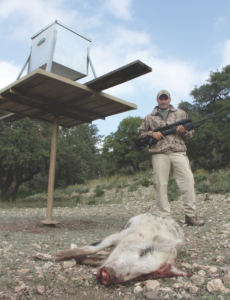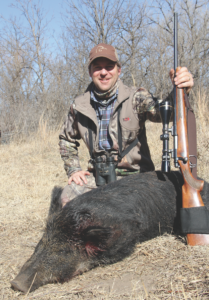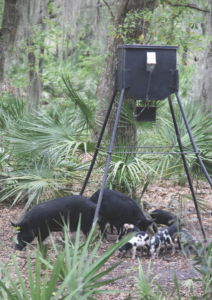They’ve been called rats with hooves, walking garbage disposals and 200-pound cockroaches. Unlike those pesky little insects though, feral hogs root up crops and pastures, devour turkey and quail eggs and generally wreak havoc on the landscape wherever they go.
The nation’s estimated 5 million wild pigs account for as much as $1.5 billion in damage annually. Farmers hate them, wildlife managers fear them and hunters shoot them at every opportunity. So why aren’t we putting a dent in their numbers?
Hunting Can’t Do It
As much as recreational hunters would like to fulfill that mission, they simply can’t. Research from Texas suggests upwards of two-thirds of the state’s feral hog population would have to be killed every year in order to stabilize their numbers. Texas has about 1 million hunters and an estimated 2.5 million pigs. According to the Texas A&M Extension Service, each hunter would have to kill 1/2 hogs annually to have any impact. Based on estimates from 2010, they aren’t coming close. Texans killed about 750,000 that year.

Hunting is popular, but it is having little impact on controlling feral hog numbers. (Photo by David Hart)
In some ways, hunters are actually to blame for the current situation, says South Carolina Department of Natural Resources biologist Dr. Charles Ruth.
“We know for a fact that some hunters were transporting feral pigs to new locations in South Carolina so they could have something else to hunt,” he says. “They are suddenly showing up in places that did not have them before. Our feral hogs are typically tied to our river bottom habitat. When a population surfaces a long way from typical hog habitat, you can be pretty sure they were released.”
Dale Nolte, manager of the US Department of Agriculture’s feral swine damage management program, agrees.
“We have a library of over 5,000 genetic samples from all over the country. We can show how pigs in a new, isolated population are related to pigs in another region that isn’t anywhere near the new location,” he says. “We don’t know if their numbers are increasing, but we do know that they are showing up in new places largely as a result of illegal trap and transport efforts.”
What’s more, hunters not only like to hunt hogs, they are often willing to pay for the opportunity. Countless landowners and guides charge good money for hog hunts and have a vested interest in establishing, maintaining or even increasing local populations. Other hunters simply like having hogs in the woods and will skirt the laws to see that they do.
That’s exactly why some states actually prohibit hog hunting. Tennessee, Kansas and Missouri all implemented bans on recreational hunting to remove any incentive to import and release hogs into the wild. They are instead relying on state and federal managers to trap and kill pigs.
Nolte also says baiting has led to an artificial increase in feral hog densities in some locations. More high-quality food translates to healthier females, which are capable of producing more and larger litters.
“The most effective way to reduce local hog populations is through trapping efforts. Corral traps can catch lots of hogs at once. A hunter might get two or three at a time,” says Nolte.
A New Attempt
Even better? Poison.
Scientists developed a bait laced with warfarin, a blood thinner used to treat blood clots and strokes in humans. It is fatal in high doses and has been used on feral hogs in Australia with good results. Kaput, the bait’s brand name, has also been tested in Texas where it was approved by the state’s agriculture department. The Environmental Protection Agency (EPA) also approved it.
Those initial tests in Texas, however, were met with protests from a variety of groups, including hunters who feared the poison would cut into their hunting opportunities or that poisoned pigs would end up on their own dinner plates. Hogs that eat the bait can live for a day or more.
That’s one reason Texas ended the trial use of Kaput. Efforts to conduct tests in other states have also stumbled, largely as a result of lingering questions, says Nolte.
“It can still be used by appropriate agencies because it is still approved by the EPA, but state wildlife agencies want more answers. Our agency won’t use it because it has not been subjected to the necessary NEPA (National Environmental Policy Act) reviews,” he says. “The manufacturers have commissioned more research to address those concerns.”
State wildlife managers are also concerned with the potential impact to non-target animals. Initial research involved feeders designed so only animals as strong as feral pigs could get to the poison. That prevents raccoons, deer and other smaller mammals from accessing the bait. However, it did not stop at least one bear from eating poison-laced bait during testing.
New research is looking at bear-proof feeders and even electronic animal recognition devices that open feeders for pigs but remain locked for other species. Nolte says the ultimate solution may be to avoid using Kaput in areas with bears.
Another option might be a completely different kind of poison. Recent research conducted by the USDA’s Wildlife Services is looking at a bait laced with sodium nitrite. It has also shown good results. Ironically, it is the same chemical used to preserve such meats as bacon and hot dogs. When used in proper doses, it kills pigs that consume the bait within hours.
What’s more, thorough testing has shown that it is not toxic to scavengers that might eat hogs killed from the bait. USDA research scientist Dr. Kurt VerCauteren says pigs are especially sensitive to sodium nitrite, but the toxin breaks down quickly in a pig’s system. What isn’t metabolized in the animal’s system breaks down when it is exposed to air.
“We couldn’t get coyotes sick after they consumed dead pigs. We also conducted research on vultures and found no impact on them, either,” says VerCauteren. “There is virtually no risk to hunters, either. Pigs that eat the bait are dead within an hour or two and the meat will be a dark red or even chocolate brown, so it should be obvious when the animal is dressed.”
If it does get approved for wider use, sodium nitrite-laced baits may never be available for use by the public. In other words, it won’t be on the shelves next to rat poison at your local Home Depot. Nolte figures it will take at least several more years of research, plus a lengthy approval process by the EPA before it is available for wider use. That may not be until 2023 at the earliest. And then, it will likely only be available to approved federal or state agents.
The Hunting Conundrum
Ruth says his agency would certainly consider adding poisons to their hog management efforts. Although populations seem to be stable, “The fewer pigs we have, the better off we are,” he says.
Nolte figures most other states with hogs would at least consider poisons for control efforts, as well, because wildlife managers recognize the damage feral hogs can do to the ecosystem and the benefits of removing large numbers of them.

The author with a feral hog on a late-season predator hunt. While hunting these pests is great fun, hunters aren't making much progress in helping control the overall population due to mulitiple reasons. (Photo by David Hart)
But do some state wildlife agencies really want to eradicate feral hogs? Based on some hog-hunting regulations, it doesn’t seem like it. Florida, which is home to an estimated 500,000 wild hogs, requires hunters to adhere to specific seasons on some wildlife management areas. South Carolina actually closes areas to hog hunting during some months.
“Hog hunting on our WMAs is strictly incidental to other game species that are open. In other words, you can hunt hogs during turkey season, but only with firearms legal for turkey hunting,” says Ruth. “We also close our WMAs to all hunting for a brief period so non-hunters can use them. Right or wrong, they are public lands and non-consumptive users avoid them when hunters are present.”
Few states actually keep tabs on the number of hunters who pursue these animals, but one thing is certain: Where the animals are abundant, hunting is a popular and lucrative activity. Lots of hunters plan trips to hog-rich regions, often traveling hundreds of miles for the chance at killing a few pigs. They not only buy hunting licenses, they stay in lodges and motels, eat in restaurants and generally spend lots of money in their pursuit of pigs.
Hunters, however, have to decide what is more important to the future of the sport: Protecting native habitat and wildlife or artificially propping up the sport of hunting through non-native species.
Nolte actually thinks we can have both, at least to some extent.
“I think there will always be opportunities to hunt hogs where they are abundant. We aren’t getting rid of all of them. That’s impossible,” says Nolte. “However, our agency’s mission is to reduce the damage they cause. In places where they can be eradicated, they should be. They are a non-native animal that causes a lot of damage to the ecosystem, to native wildlife and to the agriculture industry. Their overall impact is massive. We should all want to see their numbers reduced.”







